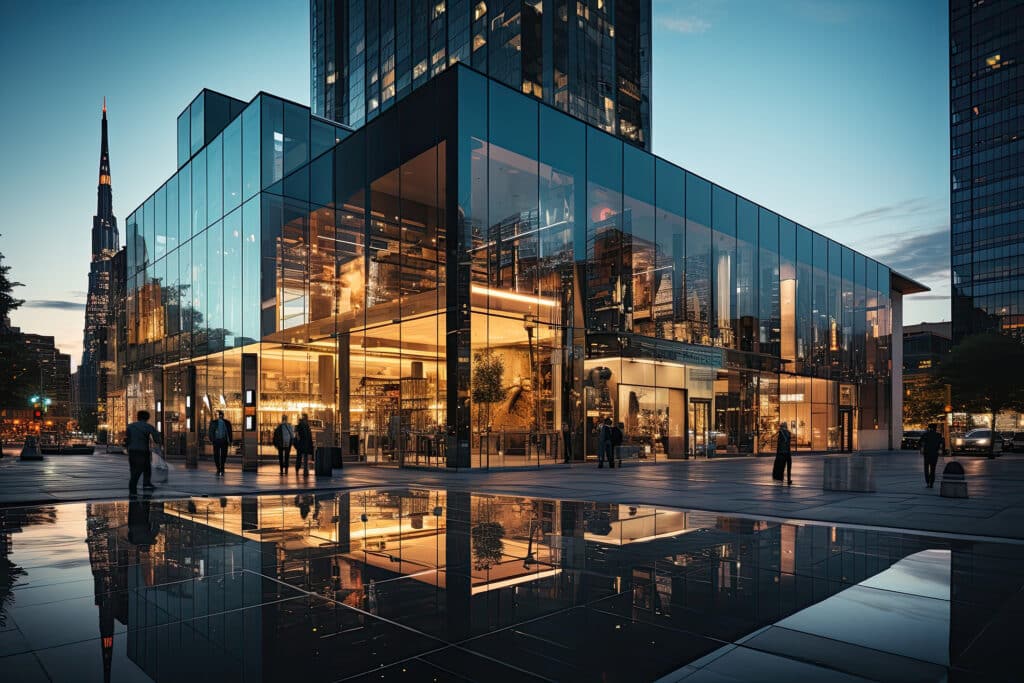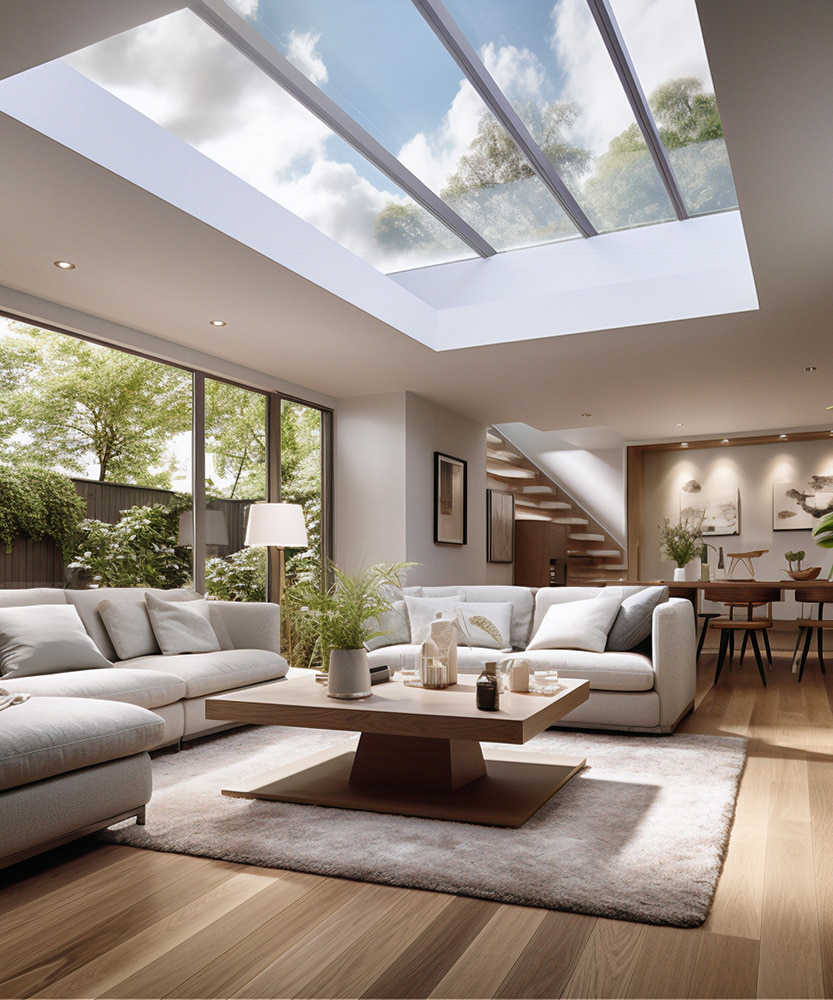You know that amazing floor-to-ceiling window in luxury apartments? The one that makes your place feel bright and airy while showing off those killer skyline views? That’s all thanks to glazing.
But what is glazing, really? And how does it give your home that ultra-high-end look and feel? Glazing is way more than just glass windows — it’s an architectural art form that transforms ordinary buildings from drab to fab.
Whether you’re a homeowner looking for a revamp or a developer wanting to wow buyers, this article will explain everything you need to know about glazing. From the science behind it to the latest innovations, you’ll learn insider secrets to redefining your space with glazing magic.
What Is Glazing? [An Overview of Window Systems]

The word “glazing” refers to the components that make up a window system. These typically include multiple panes of glass (or pieces of glass set), gas fillings like argon or krypton, and high-performance coatings. Modern glazing incorporates cutting-edge technology to improve insulation, reduce heat transfer, and block or suck up UV radiation.
Gas Fillings and Low-E Coatings
The air space between window panes can be filled with an inert gas like argon or krypton, which insulates better than air. Some invincible coatings on window panes are known as low-emissivity or “low-E” coatings. They’re microscopically thin, invisible layers of metal or metallic oxide deposited on the glass. They reflect heat into the home and improve the U-value, a measure of how well the window insulates.
Laminated and Toughened Glass
Laminated glass has a plastic interlayer sandwiched between two sheets of glass, which helps prevent the glass from shattering on impact. Similarly, toughened or tempered glass undergoes a controlled heating and cooling process to make it several times stronger than regular glass. It breaks into small granular pieces instead of sharp shards, greatly improving safety.
Specialty Glazing
More advanced glazing options include:
- Electrochromic or “smart glass” that can change transparency with an electric charge.
- Triple vacuum glazing, which uses a vacuum instead of gas in the air space.
- Aerogel, which has unparalleled insulation for its thickness.
These glazing systems significantly improve energy efficiency and indoor comfort but at a higher cost.
With so many options, glazing can be customised to meet specific needs for insulation, safety, solar control, and even high-tech functions in luxury homes and commercial buildings. If you have some special glazing requirements, we’re more than willing to help at High Level Glazing — contact us today for more info! One key step in designing a bespoke glazing system is selecting the type to work with… more on this below!
Types of Glazing Systems: Single, Double, & Triple Glazing
You must have heard about single, double, and triple glazing but are confused about their differences and applications. Join us as we break down the similarities (and dissimilarities) in this section.
1. Single Glazing
Single glazing refers to a single sheet of glass in a window frame. It’s the most basic and least energy-efficient type of glazing.

Single glazing offers minimal insulation, so it won’t do much to reduce heat loss from your home or office. It can also let in excess noise from outside. However, single glazing is inexpensive and allows maximum light into your space.
2. Double Glazing
Double glazing contains two sheets of glass with a sealed air gap in between. This air gap acts as an insulator, reducing heat transfer through the window.
Double glazing provides better insulation than single glazing, so it’s more energy efficient and can lower your heating bills. It also blocks more outside noise. Many homeowners opt for double glazing as it offers a good balance of performance and cost.
3. Triple Glazing
Triple glazing has three sheets of glass with two sealed air gaps. It offers the highest level of insulation among the three types of glazing systems.

Triple glazing can significantly reduce heat loss, cut down on energy usage, and lower your carbon footprint. It also provides the best sound insulation. However, triple glazing is the most expensive type of the three—beaten only by Quadruple-Pane Windows—and allows slightly less light into your home. But for a luxury apartment, it redefines the atmosphere.
Understanding the pros and cons of the 3 common types of glazing allows you to choose an option that suits your needs and budget. Any type of double or triple glazing will provide major benefits over single glazing, so for most homes, that’s a great place to start. One other popular term (or trend) in the glazing industry is secondary glazing. But what is it, really, and what extra benefit does it provide to glazing? Let’s find out below!
What Is Secondary Glazing? [And How It Works]
Secondary glazing is an innovative way to improve the performance of an existing glazing installation without removing the old structure. It involves installing an additional glass pane on the interior of an existing window frame. This creates a small air gap between the primary window and the glazing that acts as an insulator.
This approach to glazing offers several benefits, including:
- Reduced noise
- Improved insulation
- Minimal disruption
- Enhanced security
- Improved customisation
1. Reduced Noise
The air gap in secondary glazing acts as a sound barrier, absorbing up to 80% of outside noise. If you live on a busy street or want to reduce noise in a home office, secondary glazing can make a big difference. The sealed glass panes prevent sound from passing through, giving you a quiet, peaceful space.
2. Improved Insulation
With secondary glazing installed, you’ll notice your home feels more comfortable, and your energy bills decrease. The trapped air in the glazing reduces heat transfer through the window by up to 65%. This means less heat escapes in winter and less heat enters in summer.
3. Minimal Disruption
One of the best things about secondary glazing is that it can be installed without major renovations. The glazing units are fitted to the interior of your existing windows, so you don’t need to replace the windows themselves. This results in lower costs and minimal disturbance to your home during installation. The glazing can also be removed in the future without damaging the original windows.
4. Enhanced Security
The added glass layer in secondary glazing makes it more difficult to break through windows. This deters intruders and provides enhanced security for your home. The hermetically sealed glazing also prevents drafts, ensuring maximum comfort and safety.
5. Improved Customisation
Secondary glazing can be customised to suit your specific needs and the style of your home. Frames are available in various materials like wood, aluminium, and uPVC to match or complement your existing windows. The glazing can also be fitted to allow for opening certain windows when desired. With many options, you can achieve the perfect balance of improved efficiency and maintaining the luxury feel of your home.
In summary, secondary glazing is a cost-effective way to retain your existing glazing structure and enjoy improved comfort. If you have any style or major renovations and can’t find a competent technician for the job, feel free to contact us. At High Level Glazing, we specialise in taking residential window glazing to the next level and are more than committed to making your dream glazing a reality.
Choosing the Right Glazing System for Your Luxury Apartment

When designing your luxury apartment, the windows and glazing you choose can greatly impact the overall look and feel. For a high-end property, you’ll want glazing that provides superior insulation, soundproofing, and aesthetics.
Here are some special considerations:
1. Triple- or Quadruple-Pane Windows
For the ultimate in energy efficiency and noise reduction, consider installing triple- or quadruple-pane windows. These use three or four panes of glass with argon or krypton gas in between, which insulate far better than regular double-pane windows. Your heating and cooling costs will drop significantly, and outside noise will be barely audible. Quadruple-pane windows provide the best performance but at a higher cost.
2. Frame Material
The window frames also contribute to the glazing system. For luxury apartments, aluminium, wood, and vinyl are popular choices.
Aluminium frames are durable and low-maintenance but can conduct heat and cold. While wood and vinyl are both great insulators and provide a more custom look, vinyl is inexpensive and may not seem as high-end. You may also consider composite or fibreglass frames, which offer the benefits of multiple materials.
3. Casement or Sliding Windows
Do you prefer casement windows that crank outwards or sliding windows that glide horizontally? Casement windows often provide better sealing and insulation. Sliding windows, including glass sliding doors, create a sleek, modern aesthetic and open up your space. For a luxury property, consider oversized sliding doors leading to an outdoor area — they make a dramatic statement!
4. Bespoke Glazing
If you have a unique vision for your apartment’s glazing, consider custom or bespoke options. Speciality glass like electrochromic or switchable glass can be pricey but enables you to tint windows with the touch of a button. Another excellent option is curved glass panels, which create a striking, sculptural look. Talk to a glazing expert about your ideas — with the right budget and expertise, anything is possible!
The glazing system you choose will depend on your specific goals for performance, style, and budget. But when it comes to luxury apartments, it’s hard to overinvest in windows. High-quality glazing can transform the entire feel of the space and significantly impact the value and marketability of your property.
Frequently Asked Questions
What is glazing in construction terms?
In construction, the term “glazing” is the process of fitting glass into the prepared openings of a building, such as windows and doors. It encompasses all the glass materials used in the structural elements of a building. Glazing is essential for letting in light as well as providing insulation and security.
What is the purpose of structural glazing?
Structural glazing is a construction technique where large glass panels are used as a fundamental part of a building’s structure. Glazed structures are expansive, unobstructed glass installations that can bear weight and contribute to both the aesthetic and functional design of the building.
What is the difference between structural glazing and glazing?
Glazing refers to the installation of glass on the surface or area of a building, such as windows and doors, without bearing a structural load. Structural glazing, on the other hand, has become increasingly prominent recently and involves large glass panels that are an essential part of the building’s support system, often providing both aesthetic appeal and structural integrity.
Conclusion
In summary, what is window glazing?
This construction technique is not just about making windows look pretty; it’s an architectural and engineering feat that takes precision, glaze skill, and experience to get right. For a true glazing challenge that transforms your luxury property, you need proven masters who relish the toughest assignments.
At High Level Glazing, we’re not just glaziers; we’re glazing innovators. Let us redefine the art for your next luxury development. With our glazing, you get not only ultra-high-end looks but also impressive performance.
Contact our team today to discuss your project requirements!
